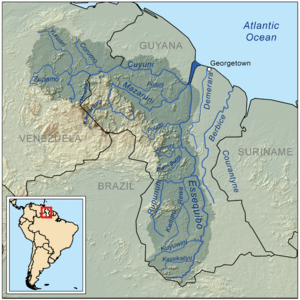Mazaruni River facts for kids
The Mazaruni River is a big river in northern Guyana. It flows into the Essequibo River, which is the largest river in Guyana. The Mazaruni River starts high up in the Pakaraima Mountains in the west. It then joins with the Cuyuni River close to a town called Bartica. As the river flows down from the Guiana Highlands, it goes past places like Issano. This river is famous for its gold and diamonds found in the riverbed.
The River's Journey
The Mazaruni River flows down from the Roraima plateau. It passes through three deep canyons with many beautiful waterfalls. The first set of falls is called Chai-chai Falls. Another set is near the village of Imbaimadai.
The last big waterfalls are below the village of Kamarang. Here, the Mazaruni River tumbles through several major falls. One of these is a long, narrow section called Chitigokein Falls. This fall ends in a deep area known as Coffy pool. The pool is named after Mehir "Cousin Body" Coffy. He was one of the last "pork-knockers" in Guyana.
Pork-knockers were small-scale miners who looked for diamonds and gold. They got their name because they carried salted pork for food. They had to "knock" the pork often to keep flies away.
After some calm water, the last big Mazaruni River Falls begin. The first is Aruwai Falls, and the last is Peaima Falls.
Soon after Peaima Falls, the river changes direction. It flows east-south-east instead of north-south. It passes the mouth of the Isseneru River. The Amerindian village of Isseneru is on the other side.
Then, other rivers like the Meamu River, Kurupung River, and Eping River join the Mazaruni. These rivers help drain the water from the Merume Mountains.
The Mazaruni River then flows past many interesting spots. These include Oranapai Rapids, Kamakusa Landing, and Banana Landing. It also passes Tiboku Rapids and Issano Landing. Finally, it reaches the mouth of the Cuyuni River. Near the village of Bartica, the Mazaruni River flows into the Essequibo River.
River Animals
The Mazaruni River's brown waters are home to many kinds of fish. Some common fish are the large electric eels, piry (a relative of the piranha), haimara, and baiara.
The most famous fish is the lau-lau. Some of these fish can weigh up to 200 kilograms (about 440 pounds)! Lau-lau fish live in the deep pools of the Mazaruni River and hunt at night.
The river also has the largest water snake, the anaconda. Local people call it the "water kamudi." Large groups of peccaries, which are wild pigs, live in the swampy areas near the river. Sometimes, hundreds of them can be seen together.
Pumas and smaller ocelots also live here. They are rarely seen because they hunt at night. Many types of monkeys live in the treetops. The howling monkey is the loudest! Many kinds of birds also share the trees. You can often see pairs of red, yellow, or blue Macaws flying by. They stay together for their whole lives.
In 2015, a jaguar was seen near the river in Cuyuni-Mazaruni.
River Plants
The Mazaruni River flows through three different types of natural areas. These are the flat tops of the Roraima Plateau, the two lower plateaus, and the lowlands. Each area has its own special plants.
The upper area is a unique land with sandstone rocks shaped by rain and wind. Exotic plants try to grow in this tough environment. The middle area has mostly savannas with some single-layer jungles. The lowest area is a thick jungle with three layers of trees. Beautiful orchids can be found in the middle and lowest areas.
River Resources
The Mazaruni River basin is rich in minerals. In 1890, the first alluvial diamonds in Guyana were found here. This happened near Isseneru village. Edward Gilkes found them by accident while looking for gold along a small stream called Putareng Creek.
Since then, the Mazaruni River and its smaller rivers (Meamu, Kurupung, and Eping) have produced a lot of diamonds. They have provided over half of all the alluvial diamonds mined in Guyana so far.
The gravels in the Mazaruni River and its tributaries also contain gold. Places like Imbaimadai, Kamarang, Aruwai, and Tiboku produced a lot of alluvial gold. This was especially true during the "golden era" of river dredging from 1980 to 1995.
Today, the river still provides some gold and diamonds, though not as much as before.
See also
 In Spanish: Río Mazaruní para niños
In Spanish: Río Mazaruní para niños


